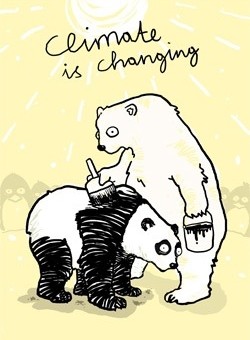 Drizzling-gray this early Monday on California’s north coast, though, not-so-chilly this morning. Supposedly, clear skies with no heavy rain percentage until Thursday, and warm — the NWS warns, however, the heat wave will be ‘short lived,’ an ‘unusually strong late-May low pressure system‘ is expected to twist across the area by the end of the week, creating cooler temperatures.
Drizzling-gray this early Monday on California’s north coast, though, not-so-chilly this morning. Supposedly, clear skies with no heavy rain percentage until Thursday, and warm — the NWS warns, however, the heat wave will be ‘short lived,’ an ‘unusually strong late-May low pressure system‘ is expected to twist across the area by the end of the week, creating cooler temperatures.
Use of the term, ‘heat wave,’ is way-relative — last month was the hottest ever recorded.
And, Duh!
Andy Pitman, director of the ARC Centre of Excellence for Climate System Science at the University of New South Wales in Australia (the Guardian): ‘“It’s clearly all heading in the wrong direction. Climate scientists have been warning about this since at least the 1980s. And it’s been bloody obvious since the 2000s. So where’s the surprise?”‘
(Illustration by Handoko Tjung, found here).
An obvious ‘gotcha‘ question.
And ‘heat wave‘ for the north coast are temperatures above 70-degrees for any length of time, but reportedly where I’m located along the shoreline, we’re to remain ‘normal‘ the next couple of days, which means the low-60s, high-50s — ambiance depending upon the wind.
However, ‘heat wave‘ is unfortunately the right term for our ‘only‘ planet — ‘only,’ as in, no other.
Further details from the Guardian:
April 2016 was the hottest April on record globally – and the seventh month in a row to have broken global temperature records.
The latest figures smashed the previous record for April by the largest margin ever recorded.
It makes three months in a row that the monthly record has been broken by the largest margin ever, and seven months in a row that are at least 1C above the 1951-80 mean for that month.
When the string of record-smashing months started in February, scientists began talking about a “climate emergency”.
Figures released by Nasa over the weekend show the global temperature of land and sea was 1.11C warmer in April than the average temperature for April during the period 1951-1980.
It all but assures that 2016 will be the hottest year on record, and probably by the largest margin ever.
The real-freaky part is no one really knows how shitty our environment will actually become, and how quickly until it is un-livable shitty.
Eric Holthaus, noted meteorologist at Slate (The Independent yesterday): ‘“It’s scary. I’m at the point where I don’t know what will happen next. We knew an El Nino would impact things, but I don’t think anyone expected this jump.”‘
In California, that El Niño looked good last year and even into 2016 for a short while, but the massive assault never came to the southern part of the state — the storms were kicked north by our ‘blob,’ and the ‘heat wave.’
From the LA Times on Saturday:
In recapping this year’s El Niño phenomena — the first since the winter of 1997-98 — the National Weather Service said the pattern “flipped” from prior El Niños that left the Northwest relatively parched and the Southwest soaking wet.
Although experts anticipated that February would be the wettest month of the year for Southern California, because of El Niño’s influence, it was actually the driest in 30 years.
Data suggests this was due in part to “the blob,” an unrelated warming of the waters along the North American West Coast from Alaska south to the Baja California Peninsula.
The warmer waters off Baja may have helped “enhance” a high pressure ridge that stretched up to California, diverting incoming storms to the north, the weather service said.
Experts suggested also that rising global temperatures may have affected the jet stream over the Pacific, which further helped to steer incoming storms north toward the Bay Area and beyond, the weather service said.
“It’s important not to assume that El Niño events of the future will behave the same,” the report stated. “But there is much to learn about how changing background conditions impact such atmospheric [conditions] … through the remainder of this century.”
And a piece earlier this month from environmental/science writer Chris Mooney at the Washington Post on Greenland’s glacier melt, this nugget:
It’s a feedback process that, if it plays out across many other similarly situated glaciers, could greatly worsen Greenland’s overall ice loss.
“These big tidewater outlet glaciers are the ones that are contributing these huge icebergs, they’re the ones that have rapidly, rapidly sped up in the last decade,” Schild said.
This makes it critically important to learn “what are the main factors…that are leading to all these fast changes,” she added.
Warm is relative…